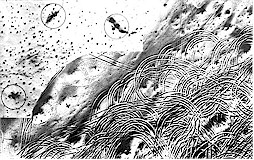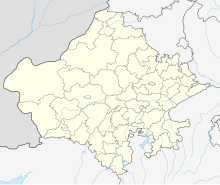Battle of Longewala
| Battle of Longewala | |||||||
|---|---|---|---|---|---|---|---|
| Part of The Indo-Pakistani War of 1971 | |||||||
 Tank tracks at Longewala. Photographic reconnaissance image taken at the time showing the desperate last minute manoeuvres by Pakistani tanks in the Longewala sector. Circles show destroyed Pakistani tanks |
|||||||
|
|||||||
| Belligerents | |||||||
|
|
|
||||||
| Commanders and leaders | |||||||
|
|
|
||||||
| Strength | |||||||
| 120 soldiers 4 Hawker Hunters 1 HAL Krishak 1 Jeep mounted M40 recoilless rifle HAL HF-24 Marut |
2,000 soldiers 1 Mobile infantry brigade 45 tanks |
||||||
| Casualties and losses | |||||||
| 2 soldiers killed 1 anti-tank destroyed |
200 soldiers killed 36 tanks lost 500+ vehicles destroyed or abandoned |
||||||
|
|
|||||||
The Battle of Longewala (4–7 December 1971) was one of the first major engagements in the Western Sector during the Indo-Pakistani War of 1971, fought between assaulting Pakistani forces and Indian defenders at the Indian border post of Longewala, in the Thar Desert of the Rajasthan state in India.
The "A" company (reinforced) of the 23rd Battalion, Punjab Regiment, under the Indian Army's 30th Infantry, commanded by Major Kuldip Singh Chandpuri, was left with the choice of either attempting to hold out until reinforced, or fleeing on foot from a mechanised infantry Pakistani force. Choosing the former, Major Kuldip Singh Chandpuri ensured that all his assets were correctly deployed, and made the most use of his strong defensive position, and weaknesses created by errors in enemy tactics. He was also fortunate in that an Indian Air Force forward air controller was able to secure and direct aircraft in support of the post's defence until reinforcements arrived six hours later.
The Pakistani commanders made several questionable decisions, including a failure of their strategic intelligence to foresee availability of Indian strike aircraft in the Longewala area, exercising operational mobility with little or no route reconnaissance, and conducting a tactical frontal assault with no engineer reconnaissance. This led to the Pakistani brigade group being left extremely vulnerable to air attack, vehicles becoming bogged in terrain not suitable for the movement of armoured vehicles as they tried to deploy off a single track, these being more susceptible to enemy fire by using external fuel storage in tactical combat, attempting to execute a night attack over unfamiliar terrain, and infantry being surprised by obstacles to troop movement causing confusion and stalling the attack during the crucial hours of darkness, when the assaulting infantry still had a measure of concealment from Indian small arms and infantry support weapon fire.
...
Wikipedia

